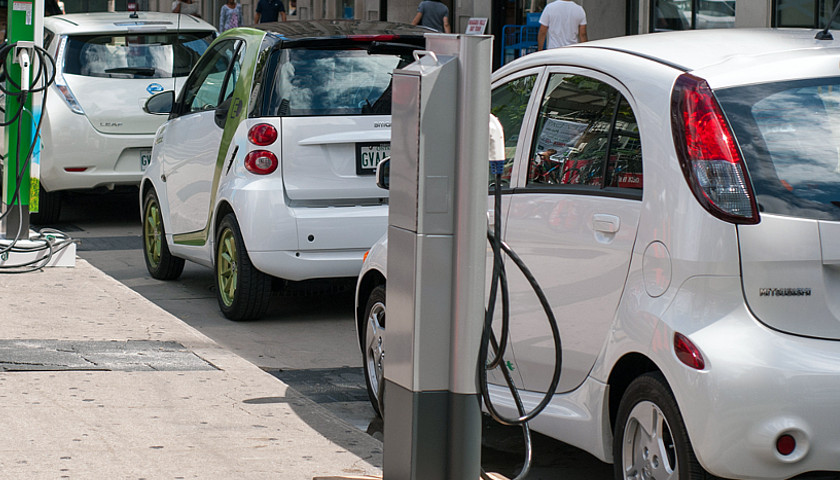Certain electric vehicles emit 11 percent to 28 percent more carbon dioxide than their diesel counterparts, even though various U.S. politicians, including U.S. Republican Sen. Lamar Alexander of Tennessee, want taxpayer subsidies for such cars.
According to a recent article on the Institute for Energy Research’s website, a study out of Germany found that electric vehicles in that country emit more carbon dioxide.
The study considered the production of batteries as well as the German electricity mix in making this determination.
But it’s not just electric cars in Germany.
“A study in 2017 by researchers at the University of Michigan found that the amount of carbon dioxide emitted by electric cars varied wildly by country,” according to the Institute for Energy Research’s website.
“The study found that an electric car recharged by a coal-fired plant produces as much carbon dioxide as a gasoline-powered car that gets 29 miles per gallon, which is a slightly higher efficiency than the 25.2 miles per gallon that is the average of all the cars, SUVs, vans, and light trucks sold in the United States over the past year. If the electricity comes from a natural gas plant, recharging a plug-in electric vehicle is akin to driving a car that gets 58 miles per gallon.”
The authors also said “lawmakers should be cautious about subsidizing electric vehicles when their electricity is generated mainly by fossil fuels because they are not lowering the carbon dioxide emissions from automobiles by doing so.”
As The Tennessee Star reported in April, Alexander has defended fighting for more tax credits for electric vehicles.
As The Star reported in February, research shows electric car manufacturers wouldn’t make a tidy profit in a pure free market system because, at least right now, there isn’t enough demand for that product.
So that’s why government gets involved.
In 2018, The Daily Caller reported EVs aren’t popular and only people with six-figure incomes generally have them.
As reported in 2015, Tennessee had 2,568 registered EVs on the road.
In three years, that number has increased slightly to 3,735 EVs. Davidson County, meanwhile, currently has 746 registered EVs, according to the Tennessee Department of Revenue.
Also, as The Star reported last fall, taxpayers have paid millions of dollars to help electric vehicle manufacturers not only get their products out on the road but also furnish electric car charging stations all over Nashville.
Prior reporting shows few people around Nashville appear to use these charging stations.
– – –
Chris Butler is an investigative journalist at The Tennessee Star. Follow Chris on Facebook. Email tips to [email protected].






No more government credit for these things. If they sell on their own merit then fine. Otherwise put them on the scrap heap. Alexander makes me ill.How many more months before this liberal is gone?
This article is correct in pointing out the issue of “embedded energy” – in other words: “Does the energy required to manufacture the automobile beget any purported energy savings over the anticipated lifetime of the vehicle?”
Generally speaking, no – and that applies to internal combustion vehicles as well as electric or hybrids. Overall, it is better to keep the existing vehicle operating rather than incur the energy deficit associated with: 1. Recovering the original vehicle’s materials; 2. Extracting and refining the new materials needed, and; 3. Manufacturing a new, ostensibly more energy efficient vehicle.
That’s why the so-called “cash for clunkers” was such a disaster from a perspective of energy efficiency and negative environmental impact, not to mention it’s effect on the economy and the consumer.
All-electric vehicles confer many benefits, much simpler, more efficient by far, and virtually no engine maintenance for one thing. Fewer components overall and the components themselves are more durable and less complex than an internal combustion engine….by a long shot.
The weak link in the chain of energy production and load balancing is storage. That applies to transportation as well as any other use. Viable storage is also the issue with wind and solar power – without an adequate storage mechanism you cannot mitigate the fluctuations in supply and demand. Without an adequate load, wind turbines simply self-destruct – that’s why you see so many wind turbines sitting idle, especially in periods of high wind. Hydroelectric leads the way because it is relatively inexpensive to build and maintain a dam and storage is built into the mix.
There are viable schemes, but electric utilities have a “hit man” called the Electric Power Research Institute – EPRI. Under the guise of “researching” they purposely ignore and denigrate alternative energy in order to serve their masters (EPRI is a utility-funded “independent” authority – hah!) The utilities just love centralized production and distribution. Governments love it too because it’s a reliable tax base and justifies the existence of regulatory agencies. More regulation= more bureaucrats – more opportunities for corruption.
Furthermore, why raise the chestnut of carbon emissions anyway? If you really want to discover the so-called net “footprint” of an energy source, consider the Energy Return On Investment, EROI, metric. Using EROI as a measure, surface coal is actually one of the most energy efficient sources, right up there with wind power. Check it out: https://www.carbonbrief.org/energy-return-on-investment-which-fuels-win
Now THAT’S a story worth telling and would do much to deflate the environmental argument for the war on coal.
Too expensive, limited range, hours to recharge. While on paper they have merit, the reality is a different story.
Yes, but Lamar is after the EPA to get the smoke out of the Smoky Mountains…So all is well!